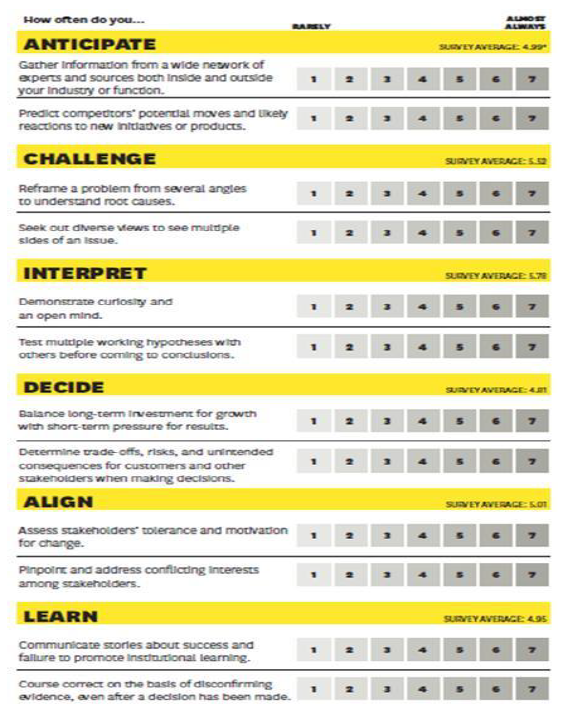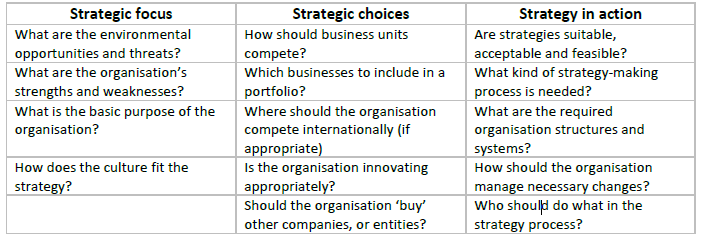Module 6: Measuring Performance Outcomes
Topic 6.6: Exploring the Role of Strategy in Delivering Public Value
Overall, strategy and strategy execution – that is – delivering on promised outcomes, is an ongoing process. The many systems, themes, processes and tools we have provided over the four PSMP units, all link to help provide you with a means by which to deliver value in your context.
As we introduce this topic, we encourage you to explore the recommended reading.
Required
20 mins
|
Please refer back to your completed diagnostic from the workshop (Schoemaker, Krupp, & Howland, 2013)[1]. Explore the completed Audit by considering your current environment and context. Revisit the questions from your point of view, within your current role.
Here is a snapshot of the Schoemaker et al (2013: 134) diagnostic tool to remind you of it. |
 |
Now we suggest being more nuanced. ake a look at your organisation’s vision, mission, values and the stated public or shared value! What do you ‘see’ and perceive? To what degree do you get the sense of ‘public value’?
A key question for you, and for your teams, is ‘how does what we do matter?’ This question correlates directly with the organisational level Public Sector Value Scorecard questions (Figure 1.2).
To help you as you complete your workplace project, consider these questions. Some may not directly impact you, or you may not be able made decisions, but someone in your organisation will, and you ought to be aware.
Table 6.3: Fourteen Fundamental Questions in Strategy (Johnson, et al., 2014)[2].
As you would notice, the three sections highlight the different yet interconnected nature of strategic issues. Strategic focus relates to the external environment, the organisation’s overall capability, goals and culture. Strategic choices focuses on strategy in terms of what the organisation does, and how it does it. (Note: while public sector entities typically are much less focused on competing, they are very focused on how they are structured and how they deliver the services within their domain. Also, they compete for dollars inside government and compete against private organisations and NGOs that can potentially delivery more efficiently).
Strategy in action is about how the strategies are formed and delivered.
The journey in this unit has focused on your implementation and execution capabilities within your agency. So, the 14 Questions are useful to you in relation to understanding and communicating to your team, the organisation’s overall strategy – Strategic focus. It also helps you to understand in what ways the organisation might deliver (or compete using the corporate sense!) – Strategic choices. Finally – while you may not have direct control over, or influence of, the mechanisms and processes in Strategy in action – it is crucial that you, as the deliverers, have a very strong and effective understanding of how the organisation’s strategy is developed and resourced.
These questions are also important to as you work with your leaders, so that you understand THEIR ROLES and RESPONSIBILITIES – since after all, you are being led by those who are charged with developing and overseeing the bigger issues of your agency!
Conclusion
To wrap-up our discussion of Building Sustainable Systems, strategy and strategy implementation, we strongly suggest that you carefully revisit the many exercises and reflections you have completed, and continue to enhance and refine your Managing Operations for Outcomes Toolkit! The theme for Module 6 overall is that you focus on building sustainable systems. This is as relevant for you as it is for your organisation.
Strategy is part of the overall existence of an organisation. We suggest that you note the many distinctions and observations around strategy, strategic thinking, and implementation. To help you, we suggest that you continue to experiment with the Strategy Journey Map Checklist as you complete your Workplace Project.
The Checklist encourages you to think of ‘Strategy as system’, which helps us understand how the key components of strategy, implementation and feedback can become embedded into the organisational fabric.
As a final observation for this Module and this Unit as a whole, we refer you to the Learning Objectives for the unit. In summary, these are to carefully explore your agency’s and more specifically, your immediate strategies, and look for factors that would deliver success, by examining external and internal factors, and identifying key operational needs and processes.
The purpose of this is to continually focus on the ways and means to develop, communicate and execute critical operational initiatives that deliver and enhance public value, as you develop your personal and professional practice.
As you complete your Workplace Project, Module 6 has encouraged you to think of the bigger picture, so that you critically and objectively reflect on how you, your team, and your larger organisational presence, works to deliver on the important and sustainable public value services, programs, initiatives and general societal objectives that are the purview of the public sector, NGOs and the not-for-profit enterprises.
Recommended
40 mins
Reading
As we introduce this topic, we encourage you to explore the following recommended reading. A useful diagnostic from the reading is included here, the Strategic Execution Audit, which you may have completed in your workshop.
Activity
Please refer back to your completed diagnostic from the workshop (Schoemaker, Krupp, & Howland, 2013). Explore the completed Audit by considering your current environment and context.
Revisit the questions from your point of view, within your current role.
- What do you notice?
- What can you change in relation to how you and your team ‘execute’ in your immediate environment?
The Social Impact Investment Taskforce (2014) proposes a measurement system for the social enterprise. Many elements of the proposals are relevant for the public sector. Note Exhibit 3: Impact Value Chain (Page 6) which highlights the chain from Inputs to Impact. Exhibit 11 Roadmap Priorities by Actor (Page 25) provides a possible way ahead for your department.
While you may not have direct authority and power to drive such a process, it is important that you have in mind at least a suitable plan that you can use to potentially influence those who do!
- Given the suggestions in the Roadmap (Social Impact Investment Taskforce, 2014), what actions can you take to prepare an ‘impact’ plan?
Activity
Think about the agency, department or the NGO etc in which you operate.
- Given your experiences with delivering on your agency’s strategic objectives, what is the overall strategy of your agency?
Consider two initiatives or projects that you have worked on during the past year.
- How do they ‘fit’ with this strategy and the strategic objectives?
Describe their core desired outcomes.
- What did they actually achieve?
- How did they achieve this?
- In your context, what ‘patterns’ can you see in terms of strategy development, execution, value assessment, and follow-up?
- What lessons can you take forward with you as you execute on your Workplace project?


